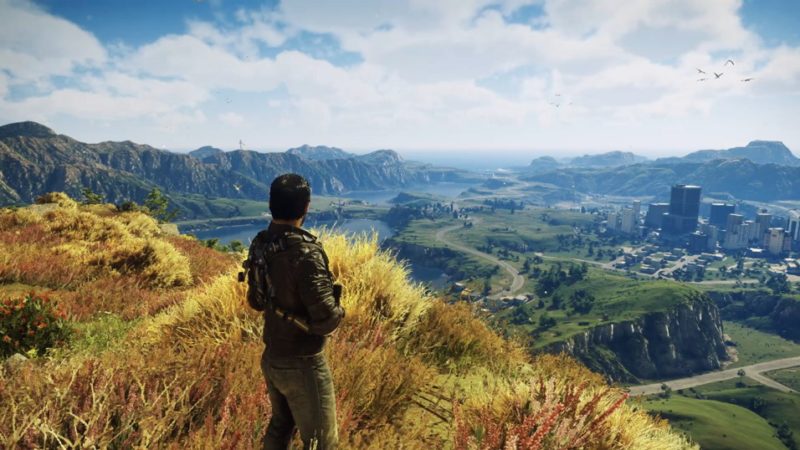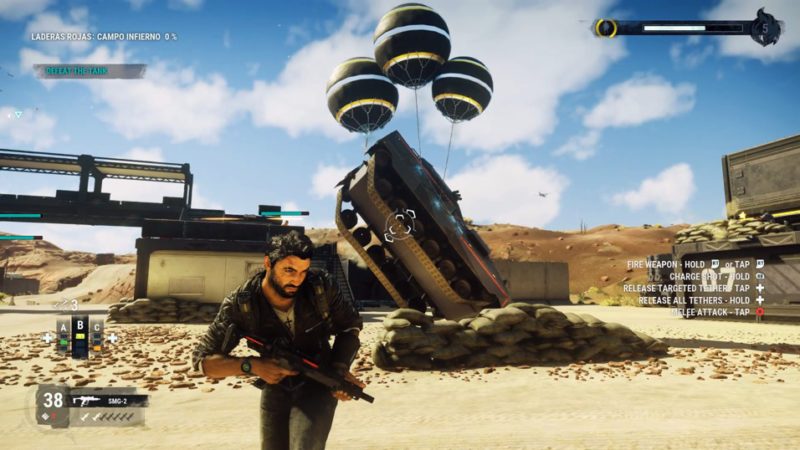
For fans of the Just Cause series, this fourth entry will be a familiar journey into the Summer action blockbuster chaos these games deliver on so well. Just Cause 4 is cleaner, more streamlined, and offers up some great setpieces and beautiful open world environments while performing admirably on the frame rate end. Avalanche Studios provides players with a few new gadgets and another new fancy island dictatorship to topple; at this point the adage for fans and developer alike seems to be “if it ain’t broke, don’t fix it.”

Much of the joy of the newest game derives from the same successes found in its predecessors: leading man Rico Rodriguez is equipped with a remarkably flexible grappling hook and parachute that allows him to maneuver with incredible finesse between land, sea, and air whether there are vehicles to hijack along the way or not. The wingsuit from Just Cause 3 returns to add yet more control to Rico’s travels by air, and new and returning grappling hook modifications allow him to tether objects together, levitate people and cars into the heavens with balloons, or send enemies flying into the horizon with miniature jet boosters–and those are just the basics.

The combat system remains fairly basic while still being suitable for the game’s eternal goal of blowing up everything in sight and destroying all opposition however you please. Weapon crates containing various sniper rifles, machine guns, grenade launchers, and rockets are always available, or easily lifted off of enemies after giving them a grappling hook beatdown. There’s not a lot of depth to the combat besides pointing Rico in a direction and pulling the trigger until things explode, but combined with the remarkable freedom the player gets while controlling Rico you’re unlikely to care about how nicely one weapon handles over another. You’ll be too busy discarding one gun for another as soon as the ammo gets low or something more exciting becomes available.

Just Cause 4 sets up Rico and new partner Mira Morales to take on yet another dictatorship, this time on the island nation of Solis. The Black Hand mercenary army, often hired by past regimes Rico toppled throughout the series, control Solis under their leader Gabriela Morales and her partner Oscar Espinosa, the president of Solis. Rico uncovers a connection between his late father’s death and the actions of both Espinosa and the Black Hand, making his mission to destroy both more personal this time around. As always, he will need to build up a revolutionary army from the local population to seize control of the country one military base at a time. As far as Hollywood-esque excuse plots go, Just Cause 4’s story is par for the course, albeit taking itself a bit more seriously than, say, Just Cause 2.

Once again, the world space is massive and all of Solis is available for Rico to unleash chaos upon. The main objective involves destroying Oscar Espinosa’s weather control machine, Project Illapa, but to reach it (fittingly tucked away in the snowy mountains in the center of the map) Rico needs to take control of the other sectors of the island and sabotage Illapa’s defenses. Progressing through new missions is open-ended and only requires the player to choose an available region of Solis to do a mission in that’s next to Rico’s Army of Chaos’ initial area of control. With each mission completed, the Army of Chaos gains more soldiers and supplies that confer bonuses to Rico and open up an increasingly large number of possible directions to expand into. This is mostly the same as the previous games, and while the freedom is appreciated, the structure of most missions grows stale quick.

Since most, if not all, of the appeal of Just Cause 4 (and the series as a whole) derives from the player’s freedom to destroy things in spectacular fashion, play with the wild physics system in novel ways, and generally enjoy the sandbox nature of the experience, the times when the player isn’t entirely free stand out as weak points. Many missions, primary or secondary, revolve around a few mundane formulas that rarely change. One formula involves Rico hacking into multiple consoles around a large location while a timer counts down and enemies swarm. Another formula requires Rico to activate a console, then find a required vehicle, and drive that vehicle up to the console to open a door so Rico can access another console inside. Yet another formula involves escorting fairly mindless allied AI companions to or from a location. There are few things that feel as dated as these escort missions, blowing things up and killing all the enemies you can while waiting and waiting for the friendly AI to realize that it should be moving towards the objective. The weird quasi-passivity that sets in during missions of this sort doesn’t complement the Just Cause experience well; the player is better off being tasked to do all the objectives rather than waiting on the AI to figure things out. These different formulas described above would be okay in limited doses, but progressing through most aspects of the game (story, weapon and vehicle unlocks, supply bonuses, etc.) requires doing a lot of these kinds of missions. By comparison, the times when the goal is simply to destroy or kill something are much more in line with the natural gameplay loop that asks the player to create a solution, rather than follow directions.

There are an incredibly large number of side missions involving stunts, via wingsuit or vehicles for the most part, many of which are so minor that spending time to set up for them successfully (particularly wingsuit stunts) is more interesting than doing the stunt itself. The rewards for these stunts are often minor: contributing points towards unlocking more variants to a particular grappling hook gadget, or occasionally unlocking a new vehicle that can be spawned on command. Getting access to new vehicles is a great reward, but the points towards grappling hook gadget mods aren’t terribly useful. Much of the value of the grappling hook is obtained early on through story missions, where its major gadgets already offer a wealth of creative options. The smaller, specialized mods for these gadgets don’t command the same type of excitement, and so the stunt missions that contribute to them are more suitable as side distractions you consider doing while traveling to a more interesting mission.

Another type of side mission involves exploring archaeological digs and moving massive stones onto platforms, or other physics puzzles, to uncover riddles about Solis’ history for one of the main characters. These missions are much quieter and more methodical than most of Just Cause 4, almost out of place even. They do offer a change of pace, however, and an opportunity to explore some of the limits to the physics system and grappling hook gadgets. They aren’t terribly involved or exciting, however, and like the stunt missions are something you consider investing some time into while on the way to do something else. Unlike the stunt missions, though, the puzzle type missions almost always take several minutes to figure out and then execute. In a game that mostly emphasizes explosions and quickly transitioning from one crazy situation to another, the puzzle missions don’t have as much entertainment potential.

The game world is beautiful to explore and traverse, featuring a nice set of biomes ranging from the tropical to rocky deserts to grasslands to snowy mountains. It’s remarkable how nice the island of Solis looks when considering its sheer size and the amount of explosions and wild physics it also supports as soon as the inevitable chaos begins. One might think sacrifices would be made to preserve a solid frame rate, but at least on the PC version the game performs admirably even during intense moments. The frame rate does drop but manages to rarely feel laggy while doing so. On the whole, the improved Apex Engine running Just Cause 4 rises to the occasion very well. Particularly impressive are the intense weather effects that the engine delivers in combination with some of the game’s major setpieces. A couple strong examples include a wild lightning storm and an awesome cyclone that really allow the engine to flaunt its ability to balance graphics, physics, and performance all at once.

Just Cause 4 is in many ways a bigger and better Just Cause 3, and that’s likely to please most fans and potential fans just fine. It’s a great looking game that also happens to play excellently, too. The mission formulas aren’t as impressive as the game deserves and grow stale outside of a few showstoppers, but the sheer amount of freedom and capacity for player-generated fun more than make up for this slump in quality. This game is a great one for spending time just screwing around and discovering what kinds of mayhem you can unleash.
8/10
JUST CAUSE 4 is a landmark entry in the series, and will release on December 4, 2018 on Xbox One, PC (Steam), and the PlayStation 4 computer entertainment system.
Steam Review
I've been gaming for 22 years, ever since my mom picked up a secondhand NES, and I've played on just about every gaming platform out there since. I think video games are one of most innovative and artistic mediums in the world today, and I'm always curious how developers will surprise me next.





More Stories
Highly Anticipated Post-Apocalyptic MMO FPS, PIONER, Launches on Steam Early Access
DAIMON BLADES Preview for Steam Early Access
ReStory Preview for Steam